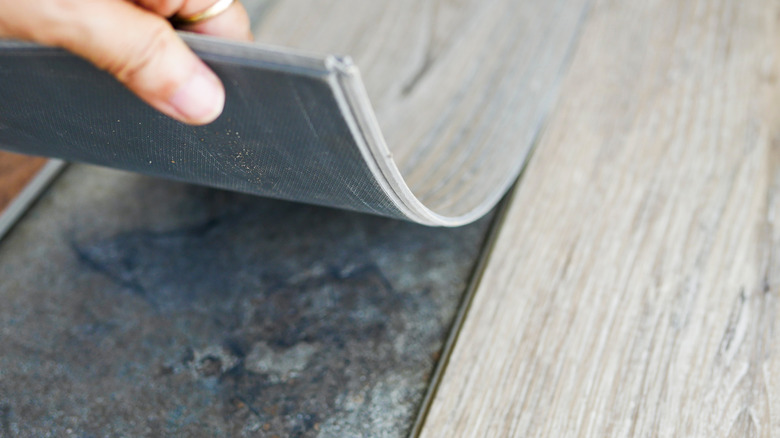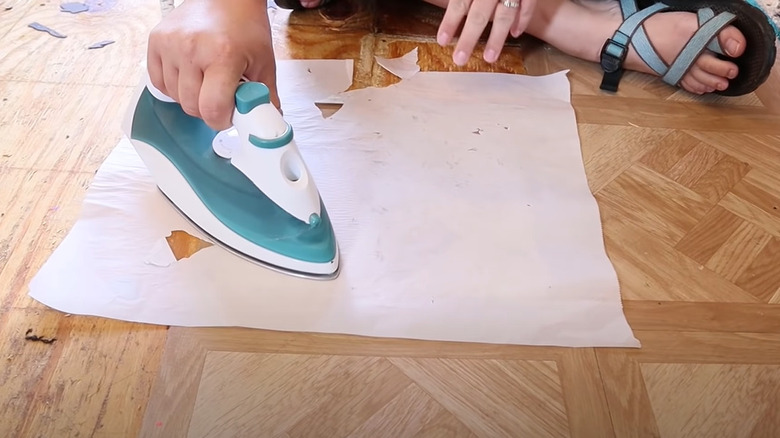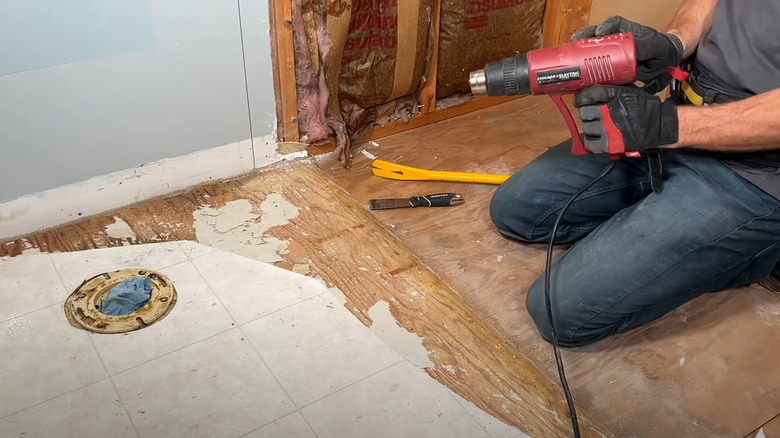If You Have A Loose Vinyl Floor Tile, Grab This Handy Kitchen Staple For A Quick Fix
Crafted from polyvinyl chloride (PVC), vinyl flooring tiles are impressive performers in the arena of longevity and low maintenance. But even this flooring superstar isn't invincible to domestic mishaps, a prime example being a loose tile. You don't want to keep those loose tiles around for too long, for moisture and dirt could wage war on the subfloor, causing further damage. Still, calling in the professionals every time a tile becomes loosened is impractical. However, with just one of the humblest kitchen staples — aluminum foil — complemented by a clothes iron and some heavy objects, you can repair a loose vinyl floor tile without removing it.
But before we proceed, let's spend a moment understanding why a vinyl tile might lift off. One of these four culprits could be to blame for this anomaly: improper installation (using incorrect or insufficient adhesive), moisture trapped under the tile, temperature fluctuations causing the tile to expand and contract, and natural house settling or unaddressed foundation issues. Recognizing these culprits is integral to longer-lasting repairs and preventative measures. Now, with these insights at your fingertips, let's guide you through how to fix vinyl flooring tile that's coming up using the abovementioned household items.
Steps to fix loose vinyl flooring tile with aluminum foil
Fixing a vinyl flooring tile begins with gathering the proper supplies: a clothes iron, aluminum foil, a brick, or weighty books, and don't skip that damp cloth for cleanup. Dive right into the repair with a clean slate — or, in this case, tile. You don't want dust or debris obstructing the resealing process beneath the repaired tile. Thus, unleash that damp cloth or vacuum on the problem tile and surrounding area. "Now for the fire!" This isn't some call-to-arms but a literal one here. Set your clothes iron to the medium setting; you need it hot enough to cause the rebellious adhesive beneath your loose tile to re-stick.
Next up is the aluminum foil. It shields your vinyl from the direct, scorching heat of the clothes iron. After all, you don't want to wreak havoc by melting or discoloring your vinyl tile. Cut it just slightly larger than the problematic tile. With the iron hot, position the aluminum foil atop the loose tile. And just like you're smoothing out a wrinkle, glide the iron over the foil with adequate pressure for about a minute. Next, while the adhesive is still warm and flexible, place bricks, a heavy piece of wood, or a stack of books onto the tile and leave them for about eight hours. The mass should keep the tile in place and expel air packets from underneath, letting the adhesive regain its sticking powers.
Caveats for repairing loose vinyl tile with aluminum foil
No doubt, DIY repair of loose vinyl tile using household items like aluminum foil and a clothes iron presents the thrilling allure of a handyman's adventure. However, here's your opening reality check: the potential for heat-induced burns is high, so be watchful. If possible, wear heat-resistant gloves. And if you don't have an iron? A hairdryer or heat gun can save the day. Though it takes longer, it can coerce the rebellious adhesive into submission just as effectively.
In the event of an extensive peel-off, extra adhesive will suffice. Warm the problematic tile, then use a putty knife to peel it off. Be careful with the tile; else, you'll be shopping for a replacement soon. Digging deeper, tidy the underlayment and remove layers of glue from the tile's back using paint thinner. This is best tacked when temperatures are at least 70 degrees Fahrenheit. Finally, coat the floor (not the tile) with vinyl adhesive. Remember, excess glue can trigger undesirable ripples. That precaution noted, press hard, wipe away the residual glue, and seal the victory with the weights.
Remember, this ingenious fix might only offer a temporary solution. Recurring vinyl floor tile peeling could indicate more intimidating issues lurking beneath your vinyl, whether a masked moisture problem or foundational impairments. Such cases demand professional intervention, with a potential remedy being installing a vapor barrier subfloor or rectifying drainage issues.


